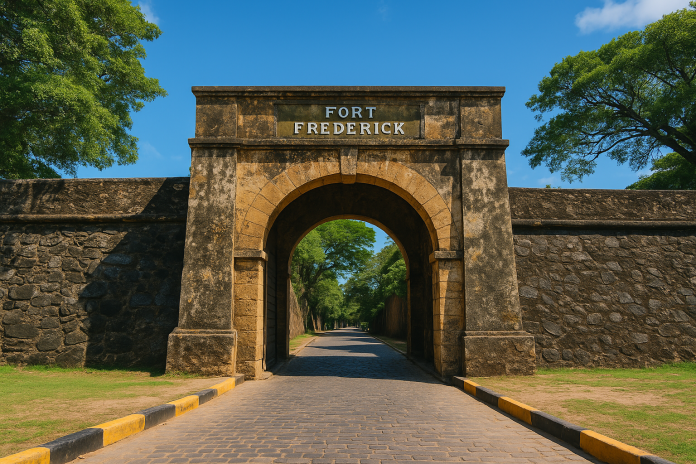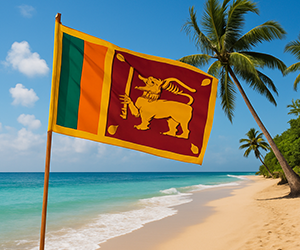🔹 Introduction
Overlooking the stunning Trincomalee Bay and steeped in centuries of history, Fort Frederick is one of Sri Lanka’s most iconic colonial landmarks. Located in the eastern city of Trincomalee, this formidable fort is not only a relic of Portuguese, Dutch, and British colonial ambitions but also a testament to the region’s strategic importance and cultural richness. Built into the rocky terrain of Swami Rock, Fort Frederick offers visitors a rare combination of military architecture, spiritual significance, and natural beauty.
Whether you’re a history buff, a spiritual seeker, or a curious traveler, Fort Frederick is a must-visit destination. Within its gates, ancient cannons, colonial-era architecture, sacred Hindu temples, and wild deer coexist peacefully. This guide will take you on a journey through the stories, secrets, and significance of Fort Frederick—a place where past and present blend seamlessly.
🔹 Historical Background
Fort Frederick was originally constructed by the Portuguese in 1624 after they destroyed the ancient Hindu Koneswaram Temple and used its stones to build the fort. They recognized the strategic advantage of Swami Rock and quickly established a military presence to control the natural harbor of Trincomalee.
In 1639, the Dutch captured the fort and reconstructed it with their own enhancements. They renamed it “Fort Fredrick” in honor of Frederick Henry, Prince of Orange. The Dutch maintained control for over a century until 1795, when the British took over the fort during their colonial expansion in South Asia.
Under British rule, the fort became a significant naval base due to its proximity to the deep-water port of Trincomalee, one of the finest natural harbors in the world. During World War II, it was used as a staging area by the Allied Forces and served as a stronghold against Japanese naval forces in the Indian Ocean.
Despite the many battles and changes of power, Fort Frederick has retained much of its colonial charm and remains an enduring symbol of Trincomalee’s strategic and historical relevance.
🔹 Strategic Importance of Trincomalee
Trincomalee’s natural harbor has long been considered one of the best in Asia, attracting maritime powers for centuries. Fort Frederick sits at the entrance of this harbor, giving it unmatched military value.
- Portuguese: Controlled access to the harbor for maritime trade and defense
- Dutch: Used it to monitor rival naval activity in the region
- British: Developed it as a critical naval base and radar installation during World War II
Today, while no longer in combat use, Fort Frederick remains under Sri Lankan military control, showcasing its continued strategic presence. The fort also symbolizes Trincomalee’s past as a geopolitical focal point between European empires.
🔹 Architecture and Layout of Fort Frederick
Built on the steep cliffs of Swami Rock, Fort Frederick showcases a blend of Portuguese foundations, Dutch reinforcements, and British colonial structures. The fort’s design is both practical and imposing:
- High stone walls enclosing multiple courtyards and buildings
- Arched entryway flanked by remnants of colonial emblems
- Old cannons facing the ocean and harbor
- A road that ascends through the fort toward Koneswaram Temple, passing old guard posts and deer roaming freely
Within the fort, you can still find traces of barracks, ammunition stores, and other British military constructions. Although modern elements have been added for tourism and security, the fort retains its historical ambiance.
🔹 Cultural and Religious Significance
Fort Frederick is unique among Sri Lanka’s colonial forts because it houses the sacred Koneswaram Temple, one of the five Pancha Ishwarams dedicated to Lord Shiva. This blend of military might and spiritual reverence is rare and adds a rich layer of meaning to the site.
The original temple was destroyed by the Portuguese in the 17th century. However, locals later rebuilt it inside the fort’s boundaries. Today, thousands of devotees visit the temple, especially during Maha Shivaratri and other Hindu festivals.
This dual identity—sacred and strategic—makes Fort Frederick not only a monument of colonial history but also a living place of worship and cultural expression.
🔹 What to See Inside Fort Frederick
Visiting Fort Frederick is a multi-sensory experience. Here’s what not to miss:
- Koneswaram Temple: A vibrant Hindu temple with panoramic views and religious art
- Deer roaming freely: Friendly and unafraid, adding charm to your visit
- Cannons and walls: Snap photos with colonial-era artillery
- Lovers’ Leap: A dramatic cliffside point with a tragic legend
- Military buildings: Old structures and plaques offering a glimpse into British military life
As you walk or drive up the hill, expect serene ocean views, shady trees, and historical relics at every turn.
🔹 Scenic Views and Photography Tips
Fort Frederick is one of the most photogenic spots in Trincomalee. Bring your camera or smartphone and capture:
- Golden sunrises over the Bay of Bengal
- Wide-angle shots from the cliff top at Lovers’ Leap
- Architectural details of Koneswaram Temple
- Wildlife photography of deer and monkeys
- Framing shots through fort arches with ocean backdrops
Best times to photograph are early morning or late afternoon when the light is soft and warm.
🔹 How to Visit Fort Frederick
Getting there: Fort Frederick is located less than 2 km from Trincomalee town. Tuk-tuks, buses, and taxis are easily available.
Opening hours: Open daily from 6:00 AM to 6:30 PM. The military allows entry to civilians but may restrict access during certain operations.
Entrance fees: There is no admission fee, but donations to the temple are appreciated.
Tips:
- Wear comfortable shoes for walking
- Stay hydrated and bring a sunhat
- Respect military zones and signage
🔹 Nearby Attractions
Maximize your Trincomalee experience with these nearby highlights:
- Koneswaram Temple (within the fort): Sacred and scenic
- Lovers’ Leap: A viewpoint with mythological significance
- Dutch Bay Beach: Great for a swim or picnic
- Maritime and Naval History Museum: Insight into Sri Lanka’s nautical heritage
- Pigeon Island National Park: Famous for snorkeling and coral reefs
Combine these sites for a full day of exploration.
🔹 Tips for Travelers
- Best time to visit: January to September, avoiding monsoon season
- Dress modestly: If entering Koneswaram Temple
- Pack light: Bring water, sunscreen, and a camera
- Hire a guide: Local guides offer insights into myths and military history
- Be respectful: This is both a holy site and a functioning military area
🔹 Conclusion
Fort Frederick is more than just a historic monument; it is a living, breathing space where Sri Lanka’s colonial past, religious devotion, and natural splendor come together. Its blend of cultures, eras, and environments makes it a unique and enriching stop on any journey through the island.
Whether you’re drawn by its cannons and colonial tales or its sacred shrines and scenic beauty, Fort Frederick promises a visit filled with wonder and reflection. Take your time, absorb its stories, and let this clifftop fortress leave a lasting impression on your Sri Lankan adventure.
Discover more travel gems and cultural heritage sites at lanka.guide




